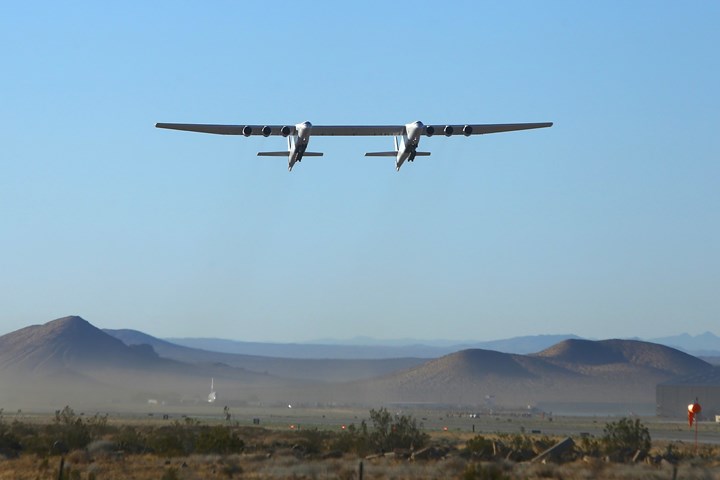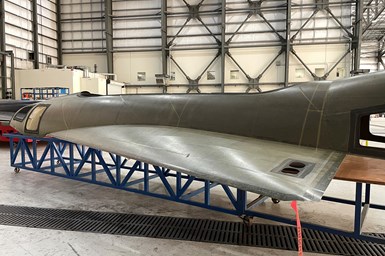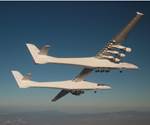Stratolaunch completes second test flight
All-composite carrier aircraft successfully flew for three hours and reached an altitude of 14,000 feet in preparation for supporting the upcoming hypersonic testbed vehicle, Talon-A.

Stratolaunch second test flight. Photo Credit: Matt Hartman
On April 29, Stratolaunch LLC (Seattle, Wash., U.S.) successfully completed the second flight of Stratolaunch, the world’s largest all-composite aircraft by wingspan. The carrier aircraft, boasting a 385-foot wingspan and a composite-intensive structure, flew for three hours, 14 minutes over the Mojave Desert and reached an altitude of 14,000 feet (4267.2 meters). As part of this latest flight, pilots further prepared the carrier aircraft to support launches of its upcoming hypersonic testbed vehicle, Talon-A, which is to act as a reliable test environment for hypersonic research, experiments and enable operational missions (and also makes use of a composite fuel gauge).
Initial results from the second flight test include:
- Confirmation of the aircraft’s performance and handling characteristics.
- Continued demonstration of the aircraft’s capability, including its payload capacity.
- Validation of the enhancements added to the Carrier Aircraft, including pressurization, gear doors and robustness to the safety systems.
“Stratolaunch is advancing our nation’s ability to be a worldwide leader in the hypersonic market,” says Dr. Daniel R. Millman, CTO of Stratolaunch. “Our flight [today] gets us another step closer to our promise of delivering the world’s premier hypersonic flight test service.”
Talon-A is a fully reusable, autonomous, liquid rocket-powered Mach 6-class hypersonic vehicle with a length of 28 feet (8.5 meters), wingspan of 14 feet (4.3 meters) and a launch weight of approximately 6,500 pounds (2,948 kilograms). The vehicle will provide more than 60 seconds of hypersonic flight test conditions and glide back for an autonomous landing on a conventional runway.
The company’s hypersonic program, announced last year, is said to have seen significant progress in high-speed vehicle manufacturing, as well as the development of a variant of the Hadley liquid rocket engine, which is being designed by Ursa Major Technologies (Berthoud, Colo., U.S.) specifically for the Talon-A testbed vehicle.

Talon-A composite upper skin. Photo Credit: Stratolaunch
Stratolaunch is currently assembling both a Talon-A Separation Test Article, which will be the first Talon-A vehicle carried and released by the carrier aircraft, as well as the first rocket-powered Talon-A vehicle. On display for attendees was a Talon-A upper skin, fabricated from out-of-autoclave (OOA) bismaleimide (BMI) carbon fiber and slated to be a component of the second hypersonic vehicle. Also highlighted was a Hadley engine, an oxidizer rich staged combustion engine in the 5,000-lb-foot thrust class, which is ready to be installed and tested in Stratolaunch’s under-construction propulsion test facility.
“We’re focused on safely and securely releasing operational hypersonic vehicles from our carrier aircraft,” says Dr. Zachary Krevor, COO of Stratolaunch. “This test flight provided valuable insights and data to help us continue this journey.”
Related Content
-
NASA launches composite solar sail into space
Sunlight-based propulsion system, supported by carbon fiber-reinforced booms, will undergo weeks-long testing to demonstrate and verify its capabilities.
-
Low-cost, efficient CFRP anisogrid lattice structures
CIRA uses patented parallel winding, dry fiber, silicone tooling and resin infusion to cut labor for lightweight, heavily loaded space applications.
-
Composite molding compound replaces Invar for lightweight small satellite structures
Patz Materials and Technologies and Lawrence Livermore National Laboratory developed a new monolithic optics housing with 80% less weight, near-zero CTE and the high-volume manufacturing required for commercial space.
















